Now that all the festivities have kicked off I see a whole lot of recipes on different blogs pertaining to the celebrations. One can have a gala time in India irrespective of which religion/faith he/she belongs to – almost everybody is celebrating their respective feasts and most commonly the harvest feast is celebrated across most of South India. The first of the season’s crop (new crop) is offered to God and a whole lot of celebrations are carried out. In Mangalore, the Catholic community celebrates the harvest feast on the 8th of September which is also the birthday of Mother Mary and is called as the Nativity of The Blessed Virgin Mary (BVM). The term Nativity means ‘birth’ and hence is also used for the birth of Christ, also popularly known as Christmas. I won’t get into the details of Christmas right now as I have a whole bunch of posts for my favourite season which will come in December. For now, let me tell you about the harvest feast as we celebrate it.
In preparation of the celebration (the Nativity of the BVM), nine days of prayers are held prior to the actual day. This is known as the Novena (pronounced as noh-veena) held every evening following the Mass. Small children take baskets full of flowers as an offertory to Mother Mary. When I was little, I would be so excited to come home from school, quickly finish my tea and run off to the garden to pluck the newly bloomed flowers – Jidde (Wild Balsams), Wild Violets, Roses, Glass Flowers (not sure of the botanical name) and Hibiscus to name a few. The entire church would be fragrant with so many flowers. Right after the mass, all of us would gather on the church grounds, form a circle as the choir would sing ‘Sakked Sangatha Melyaan’ (meaning ‘let us all gather with flowers to honour Our Lady) and offer the flowers to Mary in tandem with the song ‘Moriyek Hogolsiyaan’ (meaning ‘let us offer praises to Our Lady). Right after this ceremony, sweets would be distributed and we would eagerly wait for them. Mysore Pak (Mangalorean version), Maalpuri (similar to Mumbai’s Malpua), Peda, Khadi, Mithai Laddoo (Boondhi Laddu), Saat, Penuri (a hybrid of the Saat and Jhangri) (see some pictures here) are among the sweets I loved most and those that got distributed. These sweets were usually donated by some kind donors (usually one of the wealthy people from our church) and if we were lucky we got individually wrapped Banana or Wheat Halwa.
On the day of the feast – September 8th, we would rise early to go for Mass and the offering of flowers was held prior to the Mass. My dad used to get some special flowers from the market to fill our baskets with. Jasmine (Kaley, Mallige), Marigold (Shivnthi, Gonde), Crossandra (Abolein/Abbalige/Kanakambara), Daisies and Asters – all of which were sold for a bomb. Right after the Mass we had to assemble in the adjoining church hall or school where the season’s fresh Kobu (Sugarcanes) were distributed to the kids. This Kobu Vaantche (distribution of Sugarcanes) programme would always be the most chaotic but also the best as each one of us would vying for the fattest and juiciest Sugarcane of all.
This was also the day when a complete vegetarian meal would be cooked at home. This is called the ‘Novein Jowaan‘ (meaning new meal). Usually the items prepared would be in odd numbers – 5, 7, 9 or 11 items if the one who cooked got really enthusiastic. Cooking was also done in great fervour and before savouring the meal the entire family would gather for prayers – to thank the Almighty for a good harvest and seek His abundant blessings on the family members for the coming year – the prayers would be concluded by singing a hymn and taking a sip of the ‘Novein‘ (which means ‘new’ in Konkani and also means ‘tender or first paddy (rice) of the harvest season’). Novein would be prepared by pounding a few grains of paddy that were blessed and distributed in Church, and mixing them along with milk. I will update this post with the pictures of the Novein shortly.
My mother’s menu used to consist of seven standard items such as the Alun Dento (Alun is pronounced nasally and Dento is pronounced ‘Dhento’), Sanei Sukhe (Black Chana/Garbanzo beans), Ghosalein (Ridge Gourd) Thel Piau (Oil and Onion style), Karathein (Bitter Gourd) sweet and tangy (with jaggery and tomatoes), Benda Miriyapito (Ladies Finger Pepper), Sanna (Mangalorean Idli) and Jivo Roce (freshly extracted coconut milk sweetened with jaggery and cardamom). After this splendid meal, while the adults retired for an afternoon siesta, the kids used to sit on the porch munching the juicy Sugarcane. These are one of the fondest memories I have of my childhood in Mangalore. I could have thrown in a few more memories here, but I think I have already given you a feel of how this feast is celebrated by Catholics in Mangalore. So why don’t we head straight to the recipe now?
Today’s recipe is one of the items that is probably made by everyone who celebrate this feast. The Alun Dento is a very traditional vegetarian curry that is famously made on this day if not otherwise. Alun is one of the two varieties of Colocasia differentiated by the dark coloured stalks and leaves. The leaves are used in the preparation of Pathrade/Pathrode (Steamed Rice Cakes) as well. The Dento which essentially means ‘stalk/stem’ is the stalk of a particular variety of the leafy greens that grows 4-5 ft tall – Dento Baji as we call it. The Alun and the Dento together come to make this lovely gravy.
Alun Dento
Serves 3
You Need:
- 3 stalks (Dente) of the leafy greens (approx 1-1/2 foot each) * see notes
- 6 small Colocasia (Alun) stems (approx 1 foot each)
- 3 small ambade (hog plums)
- 1/2 tsp tamarind paste (optional)ngy)
For the masala
- 2 short dry red chillies (Harekala)
- 3 long dry red chillies (Kumti/Bedgi)
- 1/2 tsp cumin (jeera)
- 2 pinches of turmeric (haldi)
- 1 level tsp mustard (rai)
- 4 cloves of garlic (Indian) with skin
- 1 small onion (lime size)
- 1-1/2 – 2 packed cups of freshly grated coconut * see notes
- salt to taste
For the seasoning
- 2-3 tsp coconut oil (preferably)
- 1 small onion finely sliced
Method:
1. Wash the stalks thoroughly. Remove the roots if any of the leafy green stalks (Dento). Remove the fibre (outer skin) of the Colocasia stalks and cut into pieces of about 1cm. Boil the Colocasia stalks with a little water, salt to taste and the hog plums for about 7-8 minutes – this is because the Colocasia is itchy and hence the pre-boiling with hog plums or tamarind. Cook the leafy green stalks in sufficient water and salt till tender. Place both these types of stalks in a vessel.
2. Grind all the ingredients mentioned in ‘For the masala‘ to a paste. Add this masala to the pre cooked stalks. Add the masala water and bring the gravy to a boil. If you prefer a tangy gravy, add the tamarind paste and mix well. Cook for a few minutes
3. In another pan heat the coconut oil and toss in the sliced onion and fry till golden in colour. Add this seasoning to the boiling gravy. Turn off the flame and cover the pan
4. Serve hot with Sanna or Rice
Notes:
1. The size of the stalks of Alun and Dento are approximate. If you have prepared it earlier you will know the quantity that is required.
2. Ideally a fresh/tender coconut is used for this preparation. By tender, i do not mean the green one sold as tender coconut for its water. The one to be used here is ideally the one where the outer husk is greenish but not too tender and inside the white flesh is juicy and the water hasn’t dried up (which means that the coconut is aged).
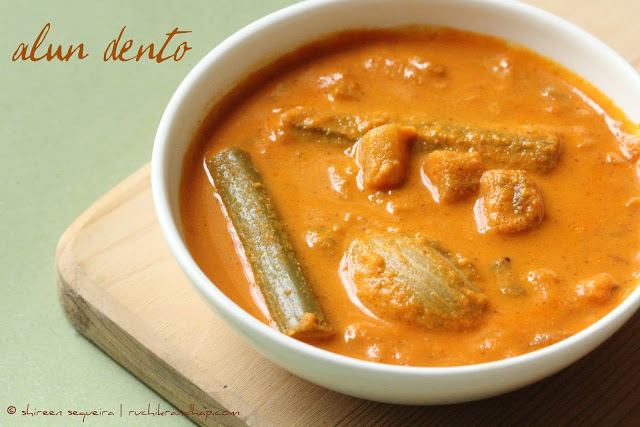
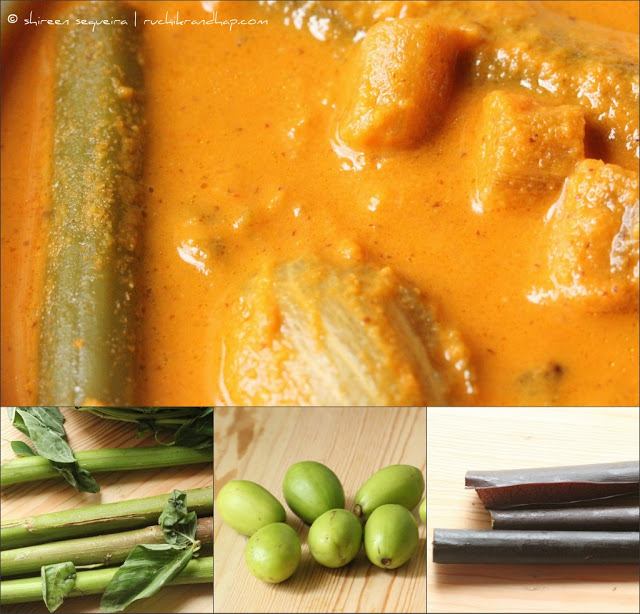
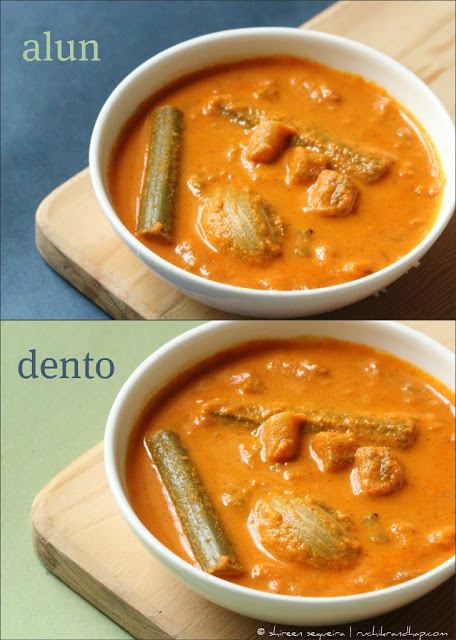
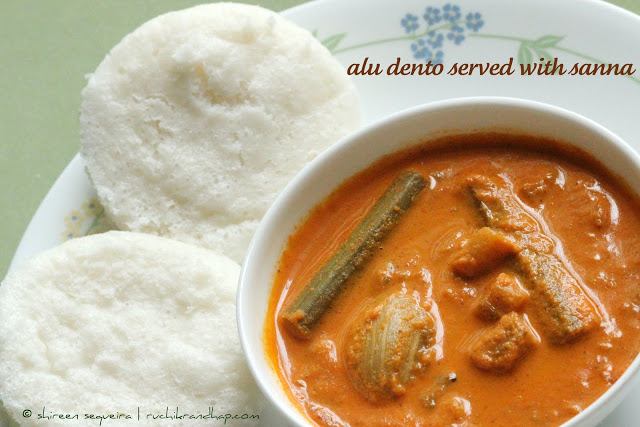
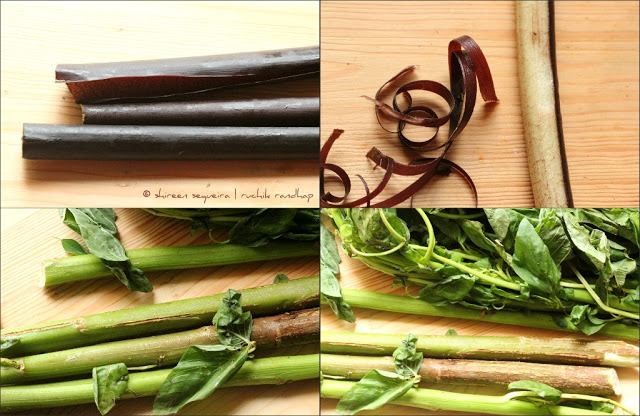
grrrrr 🙁
Lol! Sorry Sherman 🙂 I know this is temptation of the worst kind 🙁 but hope u get to make/eat it soon
Oh Shireen, you make me miss home so much when you post these beautiful pictures and recipes… last few days I am really begininng to miss home, and also I remembered that the 'flower throwing' is starting soon… how I wish Aditi could experience some of that here. Keep posting sweetie, and I will keep drooling and remembering home. Love you!
Looks so rich n yummy…. Yummmmm!!!
i love ambade.This dish looks sooo good
lovely clicks shireen
charishma
Wow delicious curry,quite new for me,thanks for sharing this incredible traditional curry..
I like the base for this curry. Im not sure about the availability of the stalks here, but maybe I will make it with some other veggies! love all the different recipes you post here 🙂
absolutely love the masalas going in it, love the color and texture of the curry, yum !!!
I have never had this before…Looks so tempting…
'Jidde' I think is 'Wild Balsams' and those with multilayers and multicolours are 'Balsams'or something
Hey, thanks a ton Preethi 🙂 will update the post with that name
Very well explained Shireen!! I have seen my friends celebrate Nativity & its exactly how u have described…In school we all were given a chance to 'throw' flowers during morning prayers all 9 days & that was my fav!!! And this traditional curry looks too yummy!!! Craving for sannas & curry now 🙂
Prathima Rao
Prats Corner
Interesting recipe' haven't see those ingredients before'…looks very tempting.
http://www.kitchen-mantra.blogspot.com
lovely recipe, looks very delicious, flavourful curry..
Vow, so tempting, flavorful curry with awesome clicks.
What a lovely post, such beautiful memories and a delicious recipe too! This is what the Hearth and Soul hop is all about. Thank you for sharing your story, and your delicious curry, with us.
This was a fascinating post! Thank you for sharing how you celebrate this festival. I love how you have combined your faith, culture, and memories into one delightful post. Your curry looks delicious! Thank you for sharing your lovely post with the Hearth and Soul Post.
BTW, I am your latest follower.
Thanks Shireen,
Awesome. This brought back so many memories. Here in Toronto it is very difficult to find Ambade, leaves here. I tried cheating by replacing it with Gongura Chutney. It comes pretty close though not exactly the same.
Donism: Shireen jaise pakana sirf mushkil hi Nahi, namumkeen hai (Hindi).
Samuel
What a lovely post!!! Thank u.. 🙂
Thanks Marz 🙂
This post has taken me back into my childhood… I fondly remember going to the novenas … dressed in our best, and beautiful baskets of flowers from our garden … and to come back to an exquisite vegetarian feast … Thank you for reviving these irreplaceable times 🙂
Hi,
Tried this curry today, minus Ambaade. Couldn’t find it here in Mumbai (Kanjurmsrg) . Had lunch with my friend and his wife and they relished the traditional curry. Thanks for the post. God bless and Happy Feast.
Hi Savita,
Thank you so much for the great feedback! Happy to hear this!